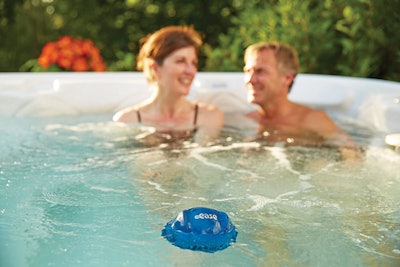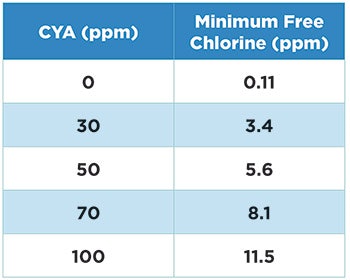

Multiple sources, including the CDC, recommend eliminating Cyanuric Acid (CYA) from hot tubs. Yet many hot tub owners use chlorine containing CYA resulting in cloudy, smelly water in as little as a few weeks. The goal is to ensure proper disinfection while making water care easier to manage so hot tub owners are delighted with their hot tubs and rave about them to family and friends. Fortunately, there are alternatives that keep water cleaner longer without constant monitoring — thus accomplishing the goal.
CYA RECAP
According to PK Data in the APSP 2018 Yearbook, 60% of all hot tub respondents said they are sanitizing with chlorine and that dichlor is the chlorine most recommended by dealers. Dichlor is about 50% CYA. This means that for each 10 ppm of chlorine added to the water from dichlor, the CYA increase is 9 ppm.
RELATED: CYA and Chlorine in Plain Language
CYA continues to build with every dose of dichlor added to the hot tub. As it builds, it slows down the ability for chlorine to kill microorganisms that can live in hot tubs. The result is within a few weeks, hot tub owners start experiencing cloudy water that is harsh to soak in and requires far more work to keep sanitized.

CYA MAKES CHLORINE A MOVING TARGET
As CYA increases, the effectiveness of the chlorine decreases. The kill time (CT value) for pseudomonas aeruginosa (the organism that causes hot tub rash) with no CYA is about 20 seconds. It is 1 minute and 30 seconds with 50 ppm CYA and nearly 2 minutes with 100 ppm CYA. To achieve the ideal 20 second kill time would require a much greater chlorine level in the water. So, as the CYA increases you need to make a corresponding increase in the free chlorine level. This makes the free chlorine level a moving target.
The table clearly shows that more and more free chlorine is needed to attain safe water as the CYA increases from dichlor use. The Environmental Protection Agency (EPA) maximum for free chlorine in hot tubs is 5.0 ppm. Therefore, free chlorine levels of more than 5.0 ppm are not recommended, except when superchlorinating and when bathers are not present. Active hot tubs using dichlor could reach the 5.0 maximum within a month.
CYA BUILDUP IS FAST
If you were to add 1 1/2 teaspoons of dichlor four times a week to a 300-gallon hot tub, the CYA level would build up to 50 ppm in as few as 4 weeks and reach 100 ppm CYA in only 7 weeks. If the hot tub is used more often and dichlor is added after each use, the buildup is even faster.
RELATED: The Cyanuric Acid Debate? Not for Hot Tubs
CYA buildup and the increase in kill times led the CDC to issue this statement, "The CDC recommends not using cyanuric acid or chlorine products with cyanuric acid in hot tubs/ spas," published in May 2016 in a CDC article called "Your Disinfection Team: Chlorine & pH."
In December 2016, the Pennsylvania Department of Health published a statement in "Public Swimming and Bathing Places: Operational and Biological Protocol Recommendation" stating, "At even moderate levels of cyanuric acid, the amount of time it takes chlorine to kill pseudomonas aeruginosa (the bacteria that causes 'hot tub itch') can be as much as a hundred times as long as in a hot tub or spa without cyanuric acid."

PROBLEMS RUIN HOT TUB ENJOYMENT
High levels of CYA have also been known to cause corrosion because it is part of the Total Alkalinity (TA) of the water. When working with the Langelier Saturation Index (LSI) to balance water, you must account for the CYA level. To do that, subtract about 1/3 of the CYA reading from the TA reading. The result is your TA may be lower than you think. This could result in corrosive water that is damaging to surfaces and metal components and a hot tub that is unpleasant to soak in.
RELATED: CYA: Ally for Pools -- Havoc for Hot Tubs
For hot tub owners, CYA buildup has a myriad of negative effects including cloudy and smelly water, skin irritations and worse. Even so, when disgruntled customers look for answers, they are told to add more chlorine to "shock the tub," which only compounds the problem by adding even more CYA. After as little as 2 months, there's no way for chlorine to recover. Owners are forced to empty their hot tubs prematurely, which leads to frustration and the perception that owning a hot tub is difficult.
THE CYA-FREE SOLUTIONS
Thankfully, there are EPA regulated disinfection options for hot tubs that do not contain CYA. King Technology, Inc. has the only chlorine alternative in SmartChlor®; it's used with FROG®'s mineral technology to kill bacteria 2 ways. This self-regulating chlorine sanitizer maintains a consistent low 0.5 to 1.0 ppm chlorine level for 3-4 weeks. When the SmartChlor is spent, users simply replace the cartridge for another 3-4 weeks of worry-free water care.

King Technology, Inc. also offers a bromine solution, which contains no CYA. FROG Serene® uses minerals with granular bromine in convenient prefi lled cartridges that fl oat in the hot tub. The minerals on all FROG hot tub products last 4 months, while the bromine for FROG Serene lasts 3-4 weeks.
To help dealers determine if their customers may be experiencing problems due to high CYA levels, King Technology, Inc. has a postcard available containing a single Cyanuric Acid test strip and information on how to eliminate CYA problems with FROG @ease®. For more information visit nocya.com.
Resources for this article:
https://www.health.pa.gov/topics/Documents/ Programs/Operations-SOPRecommendations.pdf
https://www.cdc.gov/healthywater/swimming/ residential/disinfection-testing.html
J.E. O'Brien, J.C. Morris & J.N. Butler, "Equilibria Aqueous Solutions of Chlorinated Isocyanurate" Ch. 14 in Alan J. Rubin's Chemistry of Water Supply, Treatment and Distribution", Ann Arbor Science Publishers, Inc., 1974, ISBN 0-250- 40036-7, pp. 333-358
Anderson, J.R., "A Study of the Influence of Cyanuric Acid on the Bactericidal Effectiveness of Chlorine," American Journal of Public Health, Oct, 1965.











































